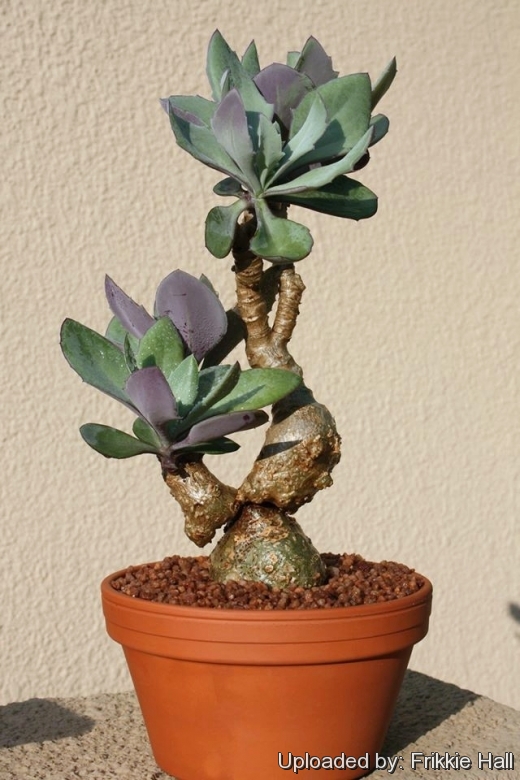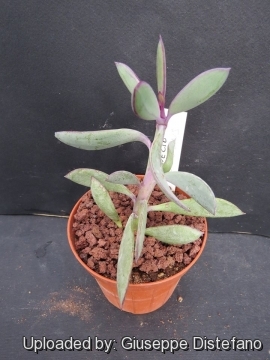Accepted Scientific Name: Senecio fulgens (Hook.f.) G.Nicholson
Ill. Dict. Gard. iii. (1886) 420. 1886 G.Nicholson

Notonia fulgens (Senecio fulgens) Photo by: Frikkie Hall
Kleinia fulgens from my caudex collection. Plant is 23cm high and caudex 7cm diameter. The leaves are green with a purple border on top. They also has a purple shade at the bottom.
Origin and Habitat: Senecio fulgensSN|30411]]SN|30411]] (Kleinia fulgensSN|30412]]SN|30412]]) is endemic to KwaZulu-Natal, Republic of South Africa, Mozambique and Zimbabwe.
Habitat and ecology: This species grows in valley on cliff ledges and cracks. On the cliffs of its natural habitat the shiny blue-grey leaves and stems tend to stand out and again the plants can be seen from a fair way away. The fleshy stems tend to grow out over the cliff and hang down, then grow back up towards the light. The Autumn flowering time from May through to June that will stretch to July as you move further inland is the most obvious time to find this species on the cliffs. The bright red flowers attract many butterflies and other insects that pollinate them. The plant has a creeping, tuberous rootstock and in habitat the aerial parts are often browsed by animals.
Synonyms:
See all synonyms of Senecio fulgens
back
Accepted name in llifle Database:Senecio fulgens (Hook.f.) G.NicholsonIll. Dict. Gard. iii. (1886) 420. 1886Synonymy: 7
back
Common Names include:
ENGLISH: Brilliant flovered Kleinia, Coral senecio
AFRIKAANS (Afrikaans): Koraalsenecio
Description: Senecio fulgensSN|30411]]SN|30411]], best known as Kleinia fulgensSN|30412]]SN|30412]], is a quite a nice looking herbaceous perennial subshrubs up to 60 cm tall with a profusion of reddish flowers. The bright orange red flower heads resemble a thistle. Succulent leaves seem to be spirally arranged and stems emerge from a tuberous succulent, shapeless rootstock. Plants are everywhere covered with a pale green glaucous bloom and are hairless throughout.
Derivation of specific name: The species name, fulgens, means shining and refers to the vibrant, scarlet colour of the flowers.
Branches: Few, about 1 cm thick, evergreen, rather soft, fleshy, weak, 60(-90) long ascending or sprawling, glaucous green, covered in leaf-scars.
Leaves: Crowded in terminal rosetes, 9(-15) long, 3-5(-7) cm wide, obovate to oblanceolate, narrowing downwards to winged base, and varied outline from entire to pinnatifid with prominent triangular pointed teeth in the upper half. Leaf colour varies from dull green-grey to bluish-grey with purpling on the underside and margins.
Inflorescence: Flower stalk, thick, sparingly-forked ending the shoots, 10-30 cm or more cm long. Capitula (flower-heads) few, 2-2.5(-3) cm across when fully open, nodding but later erect. Phyllaries (involucral bracts) 7-10 very unequal in width, membrane-edged, up to 2 cm long. Ray florets none. Disc florets 30 to 60, rich orange-red, scarlet or cerise. Pappus 10-12 mm long.
Chromosome number: 2n = 20.
Bibliography: Major references and further lectures
1) Wikipedia contributors. "Kleinia fulgens." Wikipedia, The Free Encyclopedia. Wikipedia, The Free Encyclopedia, 19 Jun. 2014. Web. 4 Feb. 2015.
2) Urs Eggli “Illustrated Handbook of Succulent Plants: Dicotyledons” Springer Science & Business Media, 2002
3) "Species Information: Kleinia fulgens Hook.f." (http://www.sntc.org.sz/flora/speciesinfo.asp?spid=3362). Swaziland's Flora Database. Web. 4 Feb. 2015.
4) Werner Rauh “The Wonderful World of Succulents: Cultivation and Description of Selected Succulent Plants Other Than Cacti” Smithsonian Institution Press, 1984
5) Clive Innes “Complete Handbook of Cacti and Succulents” Van Nostrand Reinhold Company, 01/Dec/1981
6) Hermann Jacobsen “A Handbook of Succulent Plants: Ficus to Zygophyllum” Blandford Press, 1960
7) Gordon D. Rowley “Succulent Compositae: A Grower's Guide to the Succulent Species of Senecio und Otbonna” Strawberry Press, 1994
8) James Cullen, Sabina G. Knees, H. Suzanne Cubey “The European Garden Flora Flowering Plants: A Manual for the Identification of Plants Cultivated in Europe, Both Out-of-Doors and Under Glass” Cambridge University Press, 11/Aug/2011
9) A. B. Graf “Tropica: Color Cyclopedia of Exotic Plants and Trees from the Tropics and Subtropics” Roehrs, 1978
10) Gideon Smith, Neil R. Crouch “Guide to Succulents of Southern Africa” Struik Nature, 2009
11) Pooley, E. "A field guide to the wild flowers of KwaZulu-Natal." Natal Flora Publication Trust, Durban.1998.
12) Leistner, O.A. "Seed plants of southern Africa." Strelitzia 10. National Botanical Institute, Pretoria 2000.
13) Brian Tarr, Natal National Botanical Garden, September 2002 . “Kleinia fulgens Hook.f.” in: South African National Biodiversity Institute, South <Africa.http://www.plantzafrica.com/plantklm/kleiniafulg.htm> Web. 4 Feb. 2015.
14) Michael Hickman 12.09.12 (updated on 06.11.13) “Kleinia fulgens"<http://www.ecoman.co.za/nursery/articles/art_k_fulgens.html> Web. 4 Feb. 2015.
 Notonia fulgens (Senecio fulgens) Photo by: Giuseppe Distefano
Notonia fulgens (Senecio fulgens) Photo by: Giuseppe DistefanoSend a photo of this plant.The gallery now contains thousands of pictures, however it is possible to do even more. We are, of course, seeking photos of species not yet shown in the gallery but not only that, we are also looking for better pictures than those already present.
Read More... Cultivation and Propagation: Very easy to grow, Spear Head (Senecio fulgensSN|30411]]SN|30411]]) makes a very ornamental pale blue colouring in full sun in warm climates. It is drought tolerant, but will accept irrigation. It is ideal for hot, dry spots in the garden, makes an attractive patio or porch plant in warmer climates, and can be grown as a houseplant in cooler climates. It does best in sunny warm places with plenty of water and fertilizer in summer and then a proper dormant period in the winter will make this species flower profusely. The plant's trailing growth habit make it excellent for hanging baskets. Moreover, this succulent plant is capable of surviving a temperature of -5°C. This plant is extremely easy to propagate hence its popularity in days gone by.
Soil: It requires a free draining enriched soil, mildly acidic to mildly alkaline but is very tolerant of poor soils. It can be planted in the ground – in a sandy soil or in clay – in containers, on rooftops and even on walls.
Repotting: Repot spear head whenever you see roots around the drainage holes of the pot. Replant the succulent in the evening and choose a pot with drainage holes. Use well-draining, sandy, cactus potting mix.
Fertilization: Fertilizing spear head encourages stronger, healthier growth. Fertilize the plant with a liquid 2-7-7 succulent fertilizer once a month from spring to late summer.
Watering: This plant seems to thrive with summer irrigation but does well if withheld and tolerates winter rainfall if soil drains tolerably well. It adapts to different growing conditions from extreme heat and drought, to high moisture as it has a low rot potential. One watering per month will be necessary during winter.
Exposition: They seem to do well in part shade such as at the base of trees, but thrives also in hot sunny positions and will tolerate coastal conditions. Place spear head on a lightly shaded patio, porch or balcony or near a window where it will receive direct morning sun or partly shaded afternoon sun.
Frost Tolerance: It is cultivated in open air in the tropical and warm Mediterranean climate, with temperatures which it is good to keep over the 5°C, best 10-12°C, but can withstand light frost for short periods if very dry (hardy down -5º C, even if with damage to the foliage) in these situations it will better resist if sheltered by the winter rains, seen that the humidity and low temperatures render it more sensitive to rottenness. Plants in containers however, suffered major leaf loss. Once the season is over, it is possible to bring the Spear Head in your house where it will easily tolerate the intense heat and drought. USDA Zone 9b to 12.
Wind and salt tolerance: Tolerates well high wind and second line salt wind.
Maintenance: The flower stems need to be removed to keep a tidy appearance. If the plant drops any of its leaves, remove them from the soil and discard them before they have a chance to rot or to grow mould, which can spread to the rest of the plant. This is particularly important during the winter, as the cold, wet weather encourages mould growth.
Use: The plant grows to a height of about 600 mm and is ideal for planting in rockeries or other dry, sunny spots, as the scarlet flower heads add a splash of colour in mid-winter. The succulent leaves, which are an attractive grey/green, give the plant year-round appeal and add a pleasing contrast when planted amongst short grasses or spring flowering bulbs.
Propagation: It is easy to propagate by cuttings in late spring to summer, just take a cutting of the plant let it dry for 1 or 2 weeks and stuff it in the ground (preferably dry, loose, extremely well draining soil). It lasted for weeks out of soil and once returned to the soil roots will form at the nodes and the plant carries on growing as if nothing had happened. Care must be taken not to over-water the cuttings-they are best kept on the dry side. Repot when sufficient roots have formed. Once established this pant provides a source of cuttings to give away or to fill gaps in the garden. Seed: Sow fresh seed in seed-trays containing a very well-drained potting mixture such as 50% fine milled pine bark and 50% sharp sand. Cover the seed lightly and water carefully.











